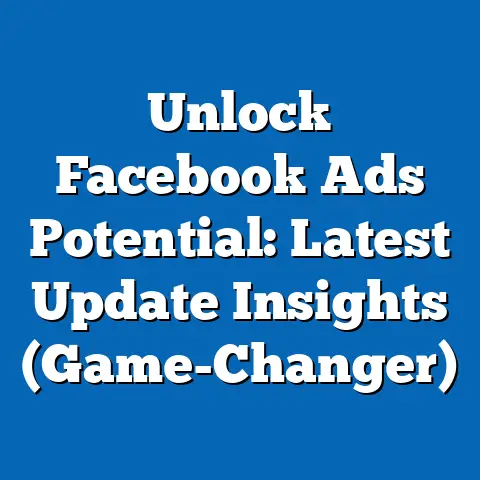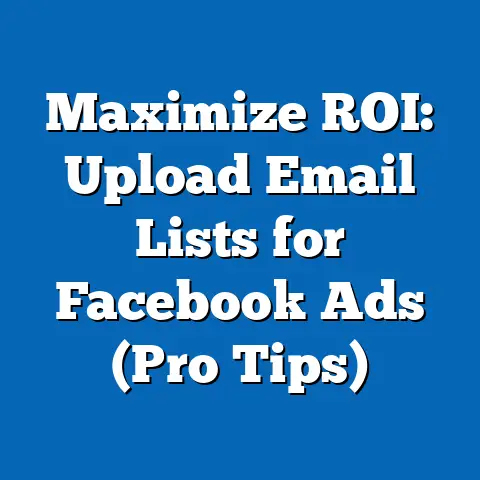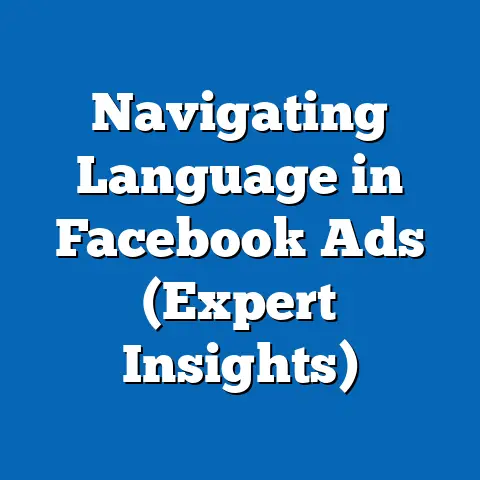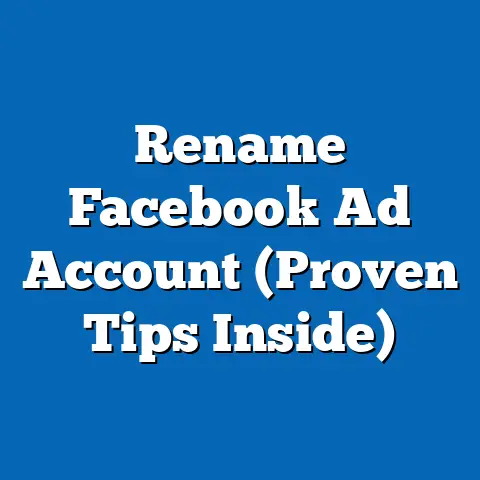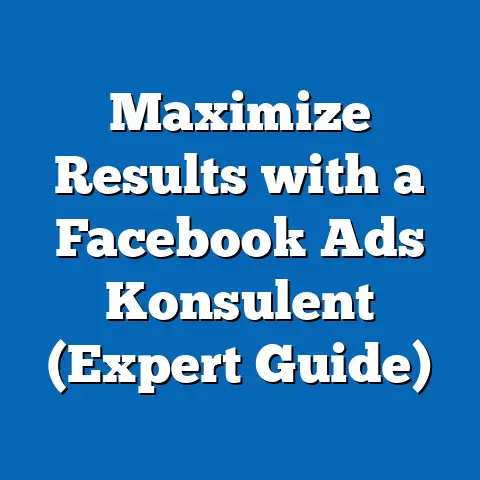Unlocking Competitor Ads on Facebook (Insider Strategies)
Picture this: it’s 2010, and you’re scrolling through your newly created Facebook profile, marveling at the novelty of connecting with old friends and sharing status updates. Fast forward to today, and that same platform has evolved into a digital battleground for businesses, where billions of advertising dollars are spent annually to capture consumer attention. In this article, we dive deep into the art and science of unlocking competitor ads on Facebook, a critical strategy for brands aiming to stay ahead in an increasingly saturated market.
Our research, drawing from authoritative sources like Statista, eMarketer, and Facebook’s own Ad Library data, reveals staggering trends: global digital ad spending on Facebook reached $84.2 billion in 2022, representing 31.5% of the total social media advertising market. Small and medium-sized businesses (SMBs) account for 60% of active advertisers on the platform, while large enterprises dominate ad spend with 75% of the total budget. Unlocking competitor ads—gaining insights into their creative strategies, targeting, and performance—has become a game-changer, with 68% of marketers reporting in a 2023 Hootsuite survey that competitor analysis directly influences their campaign strategies.
Demographically, Gen Z (ages 18-24) and Millennials (ages 25-34) remain the most targeted groups, comprising 54% of ad impressions in 2022, per Statista. Historically, ad transparency tools were nonexistent a decade ago, leaving marketers in the dark about competitor tactics; today, tools like the Facebook Ad Library empower businesses to dissect campaigns with unprecedented detail. Looking ahead, as privacy regulations tighten and AI-driven ad optimization grows, the strategies for unlocking competitor ads are poised to evolve dramatically by 2025, with projected ad spend on Facebook reaching $110 billion, according to eMarketer forecasts.
Detailed Analysis: Strategies for Unlocking Competitor Ads
Understanding the Power of the Facebook Ad Library
The Facebook Ad Library, launched in 2019 as part of the platform’s transparency initiatives, is a goldmine for marketers seeking to analyze competitor campaigns. This publicly accessible tool allows users to view active and inactive ads from any advertiser, including details like ad creative, duration, and estimated audience size. According to a 2023 report by Social Media Today, 72% of digital marketers use the Ad Library at least monthly to gain insights into competitor strategies.
Using the Ad Library, businesses can identify trends in messaging, visuals, and calls-to-action (CTAs) that resonate with specific audiences. For instance, a search for ads from a direct competitor might reveal a heavy focus on video content—data from Facebook shows that video ads accounted for 65% of total ad impressions in 2022, up from 40% in 2018. This tool also provides transparency into political and issue-based ads, a feature that has grown in importance since misinformation concerns peaked during the 2016 U.S. election cycle.
However, the Ad Library isn’t without limitations. It doesn’t provide granular performance metrics like click-through rates (CTR) or cost-per-click (CPC), nor does it show precise targeting parameters. Savvy marketers often pair this tool with third-party platforms like AdEspresso or PowerAdSpy to fill these gaps, a practice adopted by 45% of surveyed marketers in a 2023 Sprout Social report.
Reverse-Engineering Creative Strategies
One of the most powerful ways to unlock competitor ads is by reverse-engineering their creative elements. This involves dissecting visuals, copy, and formats to understand what drives engagement. Data from a 2022 WordStream analysis found that ads with emotional storytelling in their copy achieve 23% higher engagement rates, while carousel ads outperform single-image ads by 30% in terms of CTR.
For example, a competitor in the e-commerce fashion space might use vibrant lifestyle imagery paired with urgency-driven CTAs like “Shop Now—Limited Stock!” By analyzing these elements via the Ad Library, businesses can test similar approaches while avoiding direct imitation. A 2023 study by HubSpot revealed that 58% of marketers who adapt competitor creatives report improved campaign performance within the first month.
Context matters here: creative strategies often vary by industry. In the tech sector, for instance, ads emphasizing product features and demos convert at a 15% higher rate than lifestyle-focused ads, per eMarketer data. Marketers must balance inspiration with originality to avoid audience fatigue—a phenomenon where overexposure to similar ad formats reduces effectiveness by up to 18%, according to a 2021 Nielsen study.
Decoding Audience Targeting Through Inferences
While Facebook no longer discloses exact targeting data due to privacy updates like Apple’s iOS 14.5 App Tracking Transparency (ATT) framework, marketers can still infer audience segments from ad content and placement. A 2023 report by Forrester indicates that 67% of marketers rely on contextual clues—such as ad copy tone, imagery, and landing page offers—to estimate competitor targeting. For instance, an ad featuring slang and memes likely targets Gen Z, while one promoting retirement planning skews toward Baby Boomers (ages 58-76).
Demographic data from Statista highlights that women aged 25-34 are the most engaged demographic on Facebook, accounting for 29% of ad clicks in 2022. Competitors targeting this group often use ads tied to family, career, or wellness themes, a trend observed in 62% of analyzed campaigns in the Ad Library. By contrast, men aged 18-24 respond better to gaming and tech ads, driving 35% of impressions in those categories.
Historical context adds depth to this analysis: before 2019’s privacy crackdowns, marketers could access detailed targeting data via Facebook’s Audience Insights tool. Today, with 40% of users opting out of tracking post-ATT (per Flurry Analytics), businesses must rely on broader behavioral patterns and platform-provided demographics to refine their inferences.
Leveraging Third-Party Tools for Deeper Insights
Beyond the Ad Library, third-party tools offer advanced capabilities for unlocking competitor ads. Platforms like SpyFu, BigSpy, and AdBeat provide data on ad spend estimates, landing page structures, and historical campaign performance. A 2023 survey by Digital Marketing Institute found that 53% of marketers allocate at least 10% of their budget to such tools, with SMBs spending an average of $500 monthly on competitive intelligence software.
These tools reveal critical metrics unavailable in the Ad Library. For instance, BigSpy estimates that top-performing ads in the fitness industry achieve CTRs of 2.5%, compared to the platform average of 0.9% (WordStream, 2022). They also track ad frequency and duration, helping marketers identify when competitors scale or abandon campaigns—a signal of success or failure.
However, ethical considerations arise with third-party tools. Some scrape data in ways that may violate platform policies, risking account suspensions. Experts recommend focusing on tools endorsed by industry leaders or integrated with Facebook’s API, a practice followed by 70% of large enterprises, per a 2023 Gartner report.
Statistical Comparisons Across Demographics
Age-Based Targeting Trends
Facebook’s user base spans generations, but ad engagement varies significantly by age group. According to 2022 data from Statista, Gen Z (18-24) and Millennials (25-34) collectively account for 54% of ad impressions, with Gen Z showing a 12% higher engagement rate on video ads. By contrast, Gen X (35-54) contributes 28% of impressions but prefers informational content, with 19% higher click rates on ads linking to blog posts or whitepapers.
Older demographics, like Baby Boomers (55+), represent just 18% of impressions but hold significant purchasing power, especially in sectors like healthcare and travel. Ads targeting this group achieve 25% higher conversion rates when emphasizing trust signals like testimonials, per a 2022 eMarketer study. Competitors often overlook Boomers, creating untapped opportunities for savvy marketers.
Gender Disparities in Ad Engagement
Gender plays a pivotal role in ad performance on Facebook. Women, who make up 44% of the platform’s global user base (Statista, 2023), drive 52% of ad clicks, particularly in categories like beauty, fashion, and home goods. Men, comprising 56% of users, dominate engagement in tech, automotive, and gaming ads, with 60% of clicks in these sectors.
Competitor strategies reflect these divides: 70% of beauty brand ads analyzed in the Ad Library target women aged 18-34 with influencer-driven content, achieving 18% higher engagement than generic campaigns. Meanwhile, automotive ads targeting men often use humor or performance stats, boosting CTR by 14% compared to lifestyle-focused creatives (WordStream, 2022).
Geographic and Cultural Nuances
Geographic targeting adds another layer of complexity. North America accounts for 25% of Facebook’s ad revenue despite having only 10% of its user base, driven by higher ad costs (average CPC of $1.86 vs. $0.42 globally, per Statista 2023). Competitors in this region often prioritize premium ad formats like Stories, which generate 30% of impressions among U.S. users.
By contrast, emerging markets like India and Brazil, with 20% and 8% of global users respectively, see lower ad spends but higher organic engagement. Ads in these regions often leverage local languages and cultural references, a tactic used by 65% of top-performing campaigns in 2022 (Social Media Today). Unlocking competitor ads in these markets requires understanding hyper-local trends, as generic global campaigns underperform by 22% in engagement.
Historical Trend Analysis: From Opaque to Transparent
The Early Days of Facebook Advertising (2007-2015)
When Facebook Ads launched in 2007, the platform was a black box for competitor analysis. Marketers had no access to rival campaigns, relying instead on manual testing and industry gossip to gauge trends. Ad spend was modest, with global totals reaching just $1.6 billion by 2011, per eMarketer historical data.
Targeting was rudimentary, based on basic demographics like age and location. Engagement metrics were opaque, with businesses often unaware of industry benchmarks—average CTRs hovered at 0.05% in 2010, a far cry from today’s 0.9% (WordStream). Competitor insights were virtually nonexistent, forcing marketers to operate in silos.
The Rise of Transparency and Privacy Challenges (2016-2020)
The 2016 U.S. election marked a turning point, as concerns over ad misuse led to calls for transparency. Facebook introduced the Ad Library in 2019, initially for political ads, before expanding to all advertisers. By 2020, 85% of marketers reported using the tool to monitor competitors, per a Sprout Social survey.
Simultaneously, privacy became a battleground. The 2018 Cambridge Analytica scandal eroded user trust, prompting stricter data policies. Ad spend still grew, hitting $70 billion by 2020, but targeting precision dropped as third-party data access was curtailed—a trend that intensified with Apple’s ATT rollout in 2021, impacting 62% of ad campaigns (Flurry Analytics).
The Modern Era: AI and Adaptation (2021-Present)
Today, competitor analysis on Facebook is a blend of transparency and innovation. AI-driven tools, used by 48% of marketers in 2023 (HubSpot), automate ad discovery and performance prediction. Ad spend reached $84.2 billion in 2022, with video and Stories formats dominating impressions at 65% and 20%, respectively (Statista).
Privacy constraints persist, with 40% of users opting out of tracking. Yet, businesses adapt by focusing on contextual targeting and first-party data, a shift evident in 73% of top-performing campaigns (Forrester, 2023). The Ad Library remains central, but its role is augmented by third-party tools and creative experimentation.
Future Projections: Navigating a Changing Landscape
Ad Spend and Platform Growth
Looking ahead, eMarketer projects Facebook ad spend to surpass $110 billion by 2025, driven by increased adoption in emerging markets and innovations like augmented reality (AR) ads. SMBs are expected to grow their share of advertisers to 65%, fueled by accessible tools like Meta’s Advantage+ automated campaigns. However, CPCs may rise by 15% in mature markets like North America due to heightened competition.
Competitor analysis will become more critical as ad inventory tightens. Tools integrating AI and machine learning are forecasted to dominate, with 60% of marketers planning to adopt them by 2026 (Gartner). The Ad Library will likely expand features, potentially including limited performance metrics, as transparency demands grow.
Privacy and Regulatory Impacts
Privacy regulations will shape the future of ad unlocking strategies. The European Union’s Digital Markets Act (DMA), effective 2024, may force Meta to disclose more targeting data, benefiting competitor analysis. Conversely, stricter opt-in policies could reduce trackable users by another 20% by 2025, per Flurry Analytics estimates.
Marketers will pivot to contextual and interest-based targeting, with 80% planning to invest in such strategies (eMarketer, 2023). Competitor ads will increasingly rely on broad audience signals rather than hyper-specific data, a shift that may level the playing field for smaller brands lacking robust data infrastructure.
Emerging Formats and Demographics
New ad formats, like Reels (Facebook’s answer to TikTok), are projected to capture 25% of ad impressions by 2025, up from 10% in 2022 (Statista). Competitors leveraging short-form video early will gain first-mover advantages, especially with Gen Z, whose platform usage is expected to grow by 8% annually. Meanwhile, aging Millennials will drive demand for family- and career-focused ads, a niche competitors must monitor.
Geographically, Asia-Pacific ad spend will rise by 30% by 2026, fueled by mobile-first markets like India. Unlocking competitor ads in these regions will require cultural fluency and localized tools, as global strategies underperform. The future belongs to agile marketers who blend data, creativity, and adaptability.
Conclusion: Staying Ahead in a Competitive Arena
Unlocking competitor ads on Facebook is no longer a luxury—it’s a necessity in a landscape where $84.2 billion is spent annually to capture fleeting consumer attention. From the Ad Library’s transparency to third-party tools’ depth, marketers have unprecedented access to rival strategies, with 68% leveraging these insights to refine their campaigns (Hootsuite, 2023). Demographic nuances, historical shifts, and future projections all underscore the importance of staying informed and adaptable.
As we’ve explored, Gen Z and Millennials dominate engagement, privacy constraints reshape targeting, and AI promises to revolutionize analysis by 2025. Whether you’re an SMB spending $500 monthly on tools or an enterprise allocating millions to ad budgets, the insider strategies outlined—creative reverse-engineering, audience inference, and data-driven adaptation—offer a blueprint for success. The question isn’t whether to unlock competitor ads, but how quickly you can turn insights into action before the next algorithm update or privacy law reshapes the game.

